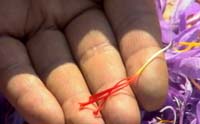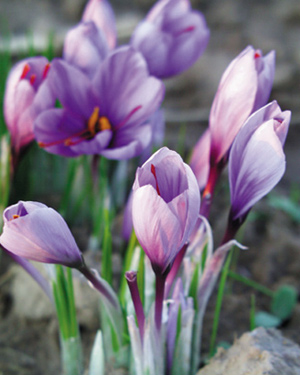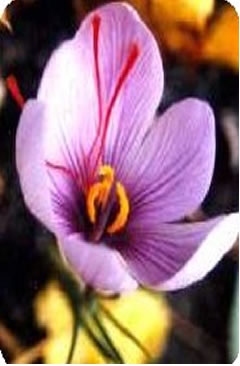Geographic Indications and International Trade (GIANT)
|
TED Case Studies
|
Iranian Saffron
|
General Info | Environment Cluster Geographic Cluster | Other Clusters
|
|---|
“Far away from the aggressive strife that prevailed in surrounding kingdoms, the Persians ate with slow, deliberate relish, pausing to breath the jasmine-scented air, to listen to the birds settle for the night in the upper branches of the almond trees, to appreciate in the murmur of their private paradises this exquisite union they had wrought between earth and heaven.”
– Pat Willard, Secrets of Saffron
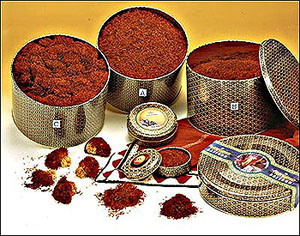

 |
|||
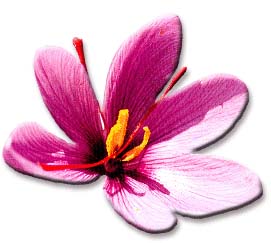 I. Identification
I. Identification
1. The Issue
 as 85% of world output. However, many regional importers are
thought to also be exporters of the Iranian saffron, in other words, re-exporting
Iranian saffron, usually under a different name and for as much as three times
the profit margin.
How and why does this happen? Can Iran seek protection? Due to the Islamic Republic’s
inability to gain membership status to the World Trade Organization (WTO), it
currently runs the risk of sacrificing its saffron rights to Spain, despite—or
perhaps partly as a result of—their recent bilateral trading agreements
with one another. While it is clear that Iran is economically engaged with Spain
via saffron and other products and industries, what does this development mean
for the Iranian saffron industry within the world saffron trade? In other words,
whose saffron is it, anyway, and is there any dispute among the contenders?
This case
study attempts to better understand this question, along with the cultural and
environmental impacts of such trade patterns.
as 85% of world output. However, many regional importers are
thought to also be exporters of the Iranian saffron, in other words, re-exporting
Iranian saffron, usually under a different name and for as much as three times
the profit margin.
How and why does this happen? Can Iran seek protection? Due to the Islamic Republic’s
inability to gain membership status to the World Trade Organization (WTO), it
currently runs the risk of sacrificing its saffron rights to Spain, despite—or
perhaps partly as a result of—their recent bilateral trading agreements
with one another. While it is clear that Iran is economically engaged with Spain
via saffron and other products and industries, what does this development mean
for the Iranian saffron industry within the world saffron trade? In other words,
whose saffron is it, anyway, and is there any dispute among the contenders?
This case
study attempts to better understand this question, along with the cultural and
environmental impacts of such trade patterns.2. Description
History and Origin of Saffron:
~Dormvit in sacco
croci~
“He is light of heart because he hath slept in a bed of saffron.”
–Author Unknown
Saffron, an exotic and elaborately extracted spice, has for centuries been in global demand. Highly coveted for its beauty, aroma, healing powers, and overall appeal, “Red Gold” is known to be “the most expensive spice in the world.” Although many may typically think of saffron as a Spanish or Indian love affair, Pat Willard aptly prefaces her book, Secrets of Saffron: The Vagabond Life of the World’s Most Seductive Spice, with a not-so-well-known fact: “Although both countries have a long tradition of cooking with the spice, it is not a native to either and was introduced by conquerors—the Moors in Spain and the ancient Persians in India.”
Saffron—or Crocus Sativus—accentuates myth, magic, medicine, and meals all over, with legendary “roots” that can be traced back through history and into story. From the cradle of civilization to Cleopatra’s courts, from Sumerian and Persian kingdoms to Greek and Biblical divinity, from the Near and Far East to the European and American West—saffron appears everywhere, both in trade and in tale.

 Crocus
and Smilax may be turn’d to flow’r s
Crocus
and Smilax may be turn’d to flow’r s
And the Curetes spring from bounteous show’rs
I pass a hundred legends stale, as these,
And with sweet novelty your taste to please.
-Ovid, Metamorphoses
From Myth to Macedonia
Empowering a nymph with the love of a mortal is perhaps the highest honor and the biggest burden that can be simultaneously bestowed, attests the Greek legend of Crocus and Smilax, to which Ovid’s above quotation makes reference. According to legend, in the heat of the moment, a most fair and supple young nymph by the name of Smilax coyly and quietly seduces the handsome mortal youth, Crocus, as he makes his way through the forest one day. Crocus, soon in the crux of nymph obsession, immediately neglects all friends and family, frequently fleeing to the forest to beckon the nymph’s beautiful body. Crocus’s adoration for Smilax, once a welcomed novelty, quickly becomes a pestering and persistent nuisance to her carefree spirit. Thus, she turns him into “a small purple flower with a fiery heart.”
It appears that across legends, Crocus’s character “blooms” from a curse of ill fortune. Another legend has it that his buddy, Hermes, the winded-sandal god of speed, struck Crocus dead with a discus by accident. To honor Crocus, God thus “tinged the flowers upon which [Hermes’s] friend lay scarlet.”
It is quite aptly, then, that saffron has a sacrificial and seductive allure. The ancient Greeks adored it, using it as a dye for clothing, hair, and even fingernails, considering it the essence of youth and livelihood. Employed in both ritual and art, it was sprinkled on theaters’ stages through Aristophanes’ The Clouds; it was known also to be an aphrodisiac, employed in Milton’s L’Allegro by prostitutes, serving as a beacon dye in their robe hems. However, not all robed ancients employ saffron via ways of sultry, sinful passion: Saffron even finds its way into the Holy Bible, specifically referenced as a sublime treasure and rarity in the Song of Solomon 4:14: “Your lips drop sweetness like honeycomb, my bride, syrup and milk are under your tongue, and your dress has the scent of Lebanon, Your cheeks are an orchard of pomegranates, and orchard full of rare fruits, spikenard, and saffron, sweet cane and cinnamon.” Elsewhere, the ancient Egyptians sacrificed cakes of saffron to their gods, while their queens used it for sensual perfumes. A master Minoan and Egyptian recipe for the queen’s perfume follows: “Saffron pounded with a crucible with myrrh until soft; mix with oil. Strain three times.”
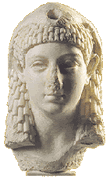
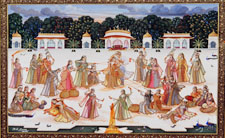

All legend aside, from where did this petite yet potent purple flowers emerge? "Roots" can be traced to the cradle of civilization, in the Fertile Crescent between the Tigris and the Euphrates. Ancient Sumerians who could understand and employ the autumn flower to ritual and medicinal ends became priests or attendants in temples and royal courts. The entrepreneurial Sumerians, however, did not cultivate saffron nor trade it, for they regarded it a product of divine intervention. Thus, recipes of saffron potions, elixirs, and even beers are found among their business records; these divine recipes and remedies comprise "the world’s first extensive written medical texts."
For a period of time, Babylonians and Assyrians cast the flower into a shadow, engaging in the less subtle ways of the warrior. It was not until the "strangers across the Zargos Mountains," the Persians, came along that the flower was elevated to a higher degree of usefulness. The inhabitants of the Pars plateau first made use of saffron for dying wool threads for their rugs: “For yellow, there were several possibilities…But if the most lively yellow was desired, one that yielded all the brilliance of the noonday sun, then only the saffron crocus would do.” From the steam of the hot dye baths, the Persians realized saffron’s usefulness for scent, sleep, love, happiness, and beauty. To this phenomenon, Willard writes:
“And often saffron was planted in secluded gardens, not only for a private ready crop but also for the unassuming, guileless charm of its petite flowers. In this long period of quiet advancement, while the kingdom bided its time, learning as it watched the ever-rumbling turmoil that wreaked havoc in neighboring countries, Persians concentrated on making their lives more comfortable and meaningful—pursuing pleasures that, in fifteen hundred years would influence, even conquer, the rest of the world.”
Clearly embraced by the Greeks as well, their first encounters with saffron stemmed from the sophisticated, stately palaces of ancient Persia, where Alexander fell in love with the allure of the Persian way:
“Alexander himself succumbed to the Persians’ sumptuous nature…As sometimes happens when life is led at such a ruthless pitch, the inherent plainness of Alexander’s Macedonian nature gave way in a dim hope for absolution, if not of peace, to the voluptuous pleasures of the Persian courts...For here was a country where a blissful life was truly led, one that was balanced between the heart and the mind, where an amalgamation of tastes drew together to create a sublime and exalted cuisine, and it had long been in place when Alexander settled in.” Thus, an admirer of Persian kingship and culture, Alexander the "Great," upon destroying the ancient palace of Persepolis, took, along with several Persian wives, the secrets of Persian saffron home with him. Thus began its spread to much of the Western world.
Crocus Cultivation
As indicated in legend, saffron itself is derived from the long reddish-orange stigma of the low ornamental saffron crocus plant's large lily-shaped purple flower. Handpicked and harvested on early autumn morning of warm nights, anywhere from 70,000 to 250,000 of them are actually needed in order to collect just one pound of pure saffron. In Central Otago trials it took 45-55 minutes to pick 1000 flowers and 100-130 minutes to remove stigmas for drying. This means it takes around 370-470 hours of work to produce 1 kg of dried saffron.
Thus, this labor-intensive but highly cherished yellow-hued wonder has established itself worldwide as “a spice to be reckoned with.” Luckily, a little bit of saffron goes a long way, as only one pinch is needed in order to flavor and color a culinary creation. In fact, more than a pinch could be not only bitter, but also ultimately toxic:
“The use of it ought to be moderate and reasonable,
for when the dose is too large, it produces a heaviness of the head and sleepiness.
Some have fallen into an immoderate convulsive laughter which ended in death.”
-Culpeper’s The Complete Herbal, 1649
The harvest of saffron crop begins with picking of the blossoms and separating the stigmas from them. The harvest period is traditionally from late September to the late December. The process begins early in the morning before sunrise. The stigmas collected are placed in shade in a warm and dried room for five to seven days to dry. In some cases the drying is done in a ritual of roasting. And finally, after the stigmas are dry, they are variously packed and stored away from light and humidity. A survey of the regions where saffron is grown will provide testimony to the fact that the knowledge of cultivation was transferred from Iran to other regions.
Quality
The International Organization for Standardization (ISO) writes saffron's testing standards. Saffron contains several chemical compounds, which cause its strength to vary between 190-250. This number refers to the amount of CROCIN, saffron's principal chemical compound, present in a laboratory reading.
Picture: (From best to worst:) Grade A: Short stigmas. ; Grade B: Stigmas attached to part of the style.; Grade C: Stigmas attached to style. Grade D: Long stigmas attached to style.
(<-- Click on picture for a glossary of Saffron Commerce Terms, including great saffron lingo, International Standards Organization information, and other helpful hints!)
FAKE SAFFRON: Beware!
As saffron is "worth its weight in gold," for years, scandalous merchants have either "cut" the product with various additives, added water weight, or simply tried to pass off cheap imitations as the real saffron. In all cases, it is next to impossible to imitate the real thing, and though offenders are not treated as harshly these days, a brief look at history sheds light on the once-thought severity of the crime--punishments were once extreme for such fakery. Powder and thread form are both found and are equal in potency and quality, however, the powder is often cheaper, because it is easier to imitate.
3. Related Cases
| BULB | IRANNUKE | ORCHID |
| SAUDPORK | PISTACHIO | HONDA |
4. Author and Date: Roddy Rasti, May 5, 2004
Due to the post-Islamic Revolution era’s political tensions,
the modern-day Islamic Republic of Iran suffers long-standing trade sanctions
from much of the Western world. Iran’s continual attempts to join the
World Trade Organization (WTO) have persistently failed from the early 1990s
well into the new millennium. In April 2004, Iran's Expediency Council Chairman
Akbar Hashemi Rafsanjani cites Iran’s “peaceful nuclear programs”
as one such obstacle to WTO membership. Washington, holding firm, refuses to
budge, as the United States, backed by Israel, has continually blocked the Islamic
Republic’s WTO entry based upon its status as a “rogue state.”
Thus, Iran has drifted away from multilateral trading, and instead,
toward establishing bilateral trade agreements with several key nations. Among
these nations stands another leading world exporter of—and simultaneously
a major importer of--Iranian saffron: Spain. Spain, with a similar climate to
Iran and a flourishing saffron trade history and industry of its own, is a WTO
member who does not form bilateral trading relations with any developed country.
It seeks to claim the exclusive rights to “Azafran de la Mancha”—or
Saffron of La Mancha—under European Union (EU) geographic indication (GI)
protection. Spain, if successful, may obtain the official rights to the Iranian
strands of the spice for good.
EU: With respect to saffron, the European Union’s Common Agricultural
Policy (CAP) of 2001 deems saffron as a “protected designation of origin”
(PDO) product, meaning that under intellectual property laws, the EU recognizes
“Azafran de La Mancha” as an item whose exclusive intellectual property
rights belong to Spain, the “geographic indication” (GI) region
thus ascribed to the good. The EU’s GI proposals in general have been
highly criticized, described by various scholars and economists as “a
protectionist tool” used to “disallow products names after a region
or associated with a particular region unless they were produced there.”
Another criticism of the EU’s GI international registry
stems from the practical concern of policing. The registry would require nations
to recognize, enforce, and police their companies and prevent them from using
those indications marked in the registry. In order to do so, a “new regulatory
bureaucracy would need to be created in each country.” The EU is already
monitoring a steadily growing 2,100+ of such GIs, and this would have to be
extended to the international registry. Despite these contentious complexities, the TRIPS agreement, through
the WTO, seeks to protect such “regional rights,” as described below. WTO: Under the 1995 Agreement on Trade-Related Aspects of Intellectual
Property Rights (TRIPS agreement) of the WTO, saffron could potentially gain
protection under Article 22. Article 22 states, “geographical indications
are, for the purposes of this Agreement, indications which identify a good as
originating in the territory of a Member, or a region or locality in that territory,
where a given quality, reputation or other characteristic of the good is essentially
attributable to its geographical origin.” Despite saffron’s often-noted Iranian origin and reputation,
there is enough “buzz” surrounding saffron’s Spanish “roots”
to warrant such possible identification. As of yet, no final decisions have
been reached regarding Spain’s “Azafran de la Mancha” GI protection,
and thus, its effects upon the future of Iran and Spain’s bilateral trade
agreements are even more uncertain. As for cases of specific dispute, there are non with respect
to Iran and Spain's intellectual property concerns. However, previously, when
the US Patent Office granted the University of Mississippi in Jackson exclusive
rights to medicinal use of saffron, the Indian Council for Scientific Research
fought American courts and proved via ancient Sanskrit texts that the knowledge
lies in the heart of Indian heart and tradition. The U.S. research monopoly
took two years to undo, and is one of the few success stories regarding intellectual
property claims. 5. Discourse and Status:
AGREE and IN PROGRESS 6. Forum and Scope:
IRAN and BILATERAL
7. Decision Breadth:
TWO: Spain and Iran
8. Legal Standing: JOINT
SPECIAL COMMISSION
III. Geographic Clusters
Globally: Saffron is currently grown and produced in, and
imported from, Egypt, Southern Europe, Spain, Morocco, Turkey, India, and Iran. Iran: The most significant quantity and quality of saffron
comes from southern Khorason, an Iranian province that, according to its Governor
General, produced 173 of the world’s 210-ton output in 2002. Qayen and
Torbat are also major cultivation areas in Iran. Because exports of saffron
brought in revenues of $51 million to Iran in 2001, Director of National Saffron
Festival Akhlaqipour and President Mohammad Khatami began encouraging further
economic development, raising media publicity of Iranian saffron, as well as
calling for upgraded and technologically innovative production means, in an
effort to raise the quality of their product to “a level at part with
international standards.” As it stands, Iran, along with Spain, is recognized
as producing the highest quality of the spice, as measured by International
Standardization Organization (ISO) guidelines. India: Historically, saffron has a rich history in India as
well. Used in Hindu rituals and traditional Ayurveda medicine, saffron is a
significant employer in Indian Kashmir and is grown in 226 villages. However,
as Iranian saffron imports make their way into Indian markets and to local Kashmiri
consumers, Indian producers feel threats to their future sustainability. Due
partly to political factors like the anti-Indian insurgency that claimed tens
of thousands of lives, the once-40,000 kilogram/year saffron production level
seen in Kashmir in the early 1990’s has dropped recently to 8,000 kg/year.
Iranian saffron is more plentiful, cheaper, and arguably of better quality. Spain: Some merchants and critics assert the claim that “the
best saffron in the world comes from Spain.” This may be true, but many
sources, such as the one below, claim that the Iranians are the ones to thank: "Due to the long experience with its cultivation, and the transfer of
methods of growing and harvesting from person to person, or generation to generation,
Iranian saffron has managed to keep its distinctive qualities in comparison
with those produced in other regions of the world. That might also explain why
Iranian saffron enjoys such an exceptional recognition for its fragrance, flavor
and color at international markets. Iran uses 10-15 t in its domestic market
and the rest is exported to Spain. Spain re-exports this product together with
its own. Trade statistics, therefore, give an inflated impression of the size
of the Spanish industry. Overall, Spanish production is in decline, due mainly
to increasing labour costs and the unwillingness of young people to enter the
industry. Spain is NOT the biggest producer, nor is ALL of its saffron production
excellent quality. (Source: http://www.saffrongold.f9.co.uk/whatis.html) Though one may argue this qualitative point, the quantifiable measures of
Spain’s agricultural success are undeniable. According to the February
2003 Agri-Food Trade Service Country Profile for Spain, it is the eighth-largest
economy in the world and the fifth-largest economy in the European Union. Its
agricultural sector holds the widest range of agricultural products between
EU countries (among which saffron is found), and is projected to experience
increased growth in the coming years. As a member of the EU, Spain does not
have bilateral trade agreements with any developed nation. However, Spain and
Iran have signed “a memorandum of understanding on the formation of a
joint Iran-Spain trade committee.” The two countries “enjoy bilateral
cooperation in oil, gas and petrochemical industries,” and are also, “cooperating
in other areas such as steel, fishing, shipbuilding, saffron and construction
stones.” 9. Geographic Locations
a. Geographic Domain: Islamic Republic of
Iran and EU
b. Geographic Site: Middle East and Europe
c. Geographic Impact: Global
10. Sub-National Factors:
No
11. Type of Habitat:
Dry temperate, Arid
 II.
Legal Clusters
II.
Legal Clusters
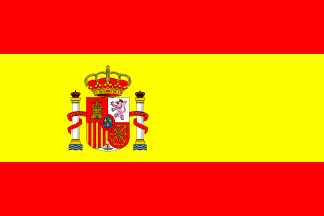
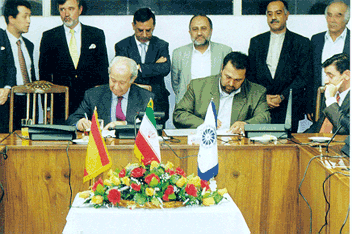
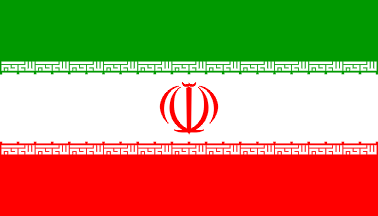

 IV. Trade Clusters
IV. Trade Clusters
